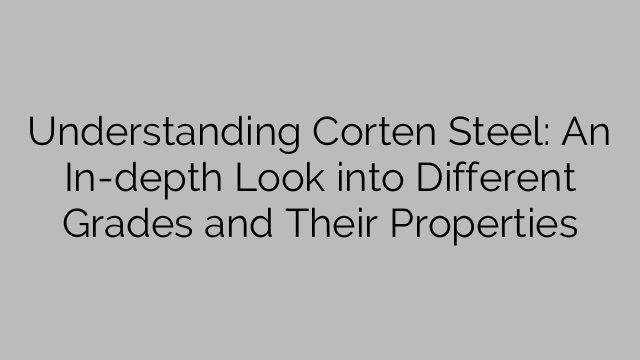Corten steel was first patented by the United States Steel Corporation in the 1930s. It was initially used primarily in railroad coal wagons and as a material for building facades. The name Corten is a blend of the words corrosion and tensile strength, implying its resistance to corrosion and its high tensile strength.
Different grades of Corten steel have been developed over the years to suit various applications and environmental conditions. The most commonly used grades are Corten A and Corten B. These grades contain a higher percentage of copper, chromium, and nickel compared to regular steel, which enhances their resistance to atmospheric corrosion.
Corten A is suitable for applications such as load-bearing structures, bridges, and tanks. It is known for its high tensile strength, formidable resistance to atmospheric corrosion, and excellent weldability. Despite its strength, Corten A is malleable and can be easily formed into various shapes. It is commonly used for architectural purposes, such as building facades and outdoor sculptures.
Corten B, on the other hand, is designed for applications that require high strength combined with good formability. It is often used in bridges, transmission poles, and other structural elements. Corten B has similar properties to Corten A but with the additional benefit of increased resistance to corrosion due to the higher percentage of phosphorus in its composition.
Apart from Corten A and Corten B, there are other grades of Corten steel available with specific properties for specialized applications. For instance, Corten Steel Grade A588 is commonly used in marine and highly corrosive environments. It exhibits exceptional weathering resistance, making it ideal for outdoor structures subjected to continuous exposure to the elements.
Cor-ten steel with improved atmospheric corrosion resistance is marked as Corten Steel IRSM 41-97. This grade is popular for fabricating railway wagons and bridges. It offers excellent durability and low maintenance, making it a cost-effective choice for outdoor installations.
Understanding Corten steel’s properties is crucial for selecting the appropriate grade to suit specific applications. Its main advantage lies in its unique ability to self-protect against corrosion. The iron oxide layer formed on its surface not only prevents rust from advancing but also gives it a distinctive rustic appearance that many designers and architects find appealing.
It is important to note that Corten steel requires weathering time to develop the desired protective oxide layer fully. The process could take several months, depending on the environmental conditions. Consequently, it is essential to factor in this time frame when planning projects involving Corten steel.
In conclusion, Corten steel offers an attractive and durable solution for architectural and outdoor applications. Its distinctive appearance, combined with its remarkable resistance to atmospheric corrosion, makes it a popular choice among designers and architects. By understanding the different grades and their properties, one can harness the full potential of Corten steel for creative and long-lasting designs.
[ad_2]

